
Susan Hayward BiographySusan Hayward was born Edith Marrener on Saturday, June 30th 1917 in Brooklyn New York. Her father, was a red-headed Irishman and her mother, Ellen, was Swedish. She grew up in a poor family. When Edith was six years old, while running after a paper parachute she had made, she was hit by an
automobile. She spent the next six months at a free clinic. Doctors feared she’d never walk again (she fractured
both legs and dislocated her hip). She used crutches until the second grade when Edith grew up a loner which is how she preferred it. While attending the Girls Commercial High School she joined the drama club. She said later “I decided that my aim was to get out of school…I became a very determined person.” Around this time she changed the spelling of her first name to “Edythe” (presumably to add class to her name). She enrolled at the Feagan Drama School in Manhattan. In 1936, she appeared as a fashion model in a pictorial short film made by Vitaphone. She then started making a living as a professional fashion model. She was featured in the Saturday Evening Post’s layout of upcoming 1937 fashions. David O. Selznick’s New York Story editor saw the layout and thought Edythe might be the “unknown” Selznick was looking for to play the role of Scarlett O’Hara in Gone with the Wind which he was currently casting. Edythe was given two (her sister Florence went with her) round-trip tickets to Hollywood to attend a screen test. The screen test did not go well. She came off as inexperienced and her reading of the lines did not satisfy Selznick. Selznick told her that she had not passed the test. He suggested she turn to New York, but she and Florence opted to stay in Hollywood.According to Hollywood legend, Edyth was on her bike when she accidentally rode and fell on the lawn of agent Benny Medford. Medford helped her up and decided to take her on as a client. He also changed her name to Susan Hayward. Using the Gone with the Wind screen test, he managed to land Susan a six-month contract at Warner Brothers. The first film she appeared in was 1937’s Hollywood Hotel (based on Louella Parson’s weekly radio show of the same name) which also featured Ronald Reagan. Parsons took much of the cast on a nine week coast to coast vaudeville tour. She described Susan as being “ultra moral and conventional”. She says Susan "seldom went out on the town at night". When she returned to Hollywood, Susan was cast as a telephone operator in The Sisters (1938) which starred Bette Davis and Errol Flynn. Probably her best early Warner Brother’s role was Girls on Probation in 1938.
After soon after not being renewed by Warner Brothers, she signed a $200 a week contract with Paramount. Her first film at Paramount was Beau Geste (1939) where she replaced the very temperamental Frances Farmer. The film features Gary Cooper, Ray Milland and Robert Preston as the Geste brothers. Susan described her part in the film this way, “I waved goodbye to the boys at the beginning and hello to them at the end.” Her next films are Paramount were Our Leading Citizen and $1,000 a Touchdown (starring comics Joe E. Brown and Martha Raye) both released in 1939. Although she didn’t appear in any films in 1940, she was borrowed by Columbia for the film Adam Had Four Sons (1941). She was third billed after Warner Baxter and Ingrid Bergman. Newsweek at the time wrote "Susan Hayward is effective in the film’s only vital role". Republic Pictures borrowed her to play along side Judy Canova in Sis Hopkins (1941). Paramount then put her in a B-mystery movie Among the
Living (1941). The New York Times called it "the dreariest film of the year", but the New York
Herald-Tribune called it a "superior psychological melodrama" and pointed out the Susan was "especially
good" in it. Paramount then put her in a B-mystery movie Among the
Living (1941). The New York Times called it "the dreariest film of the year", but the New York
Herald-Tribune called it a "superior psychological melodrama" and pointed out the Susan was "especially
good" in it.
Next Susan was giving a supporting role in Reap the Wild Wind (1942). This was a Technicolor production which touted as Hollywood’s most lavish production since Gone with the Wind. Its budget was 1.65 million dollars and the shooting schedule was 222 days long. The film premiered March 18, 1942. It starred Ray Milland, John Wayne, Paulette Goddard and Raymond Massey. Susan played Drusilla Alston the refined cousin of Goddard`s tomboy character. In 1942's The Forest Rangers (also shot in Technicolor) she received third billing after Fred MacMurray and Paulette Goddard. Next she was featured in a thankless role as a publisher’s daughter who walks out on Frederic March when she finds him in the arms of Veronica Lake in I Married a Witch (1942). Susan sang on film for the first time in Hit Parade of 1943 starring Eve Arden and John
Carroll. Also in 1943, she made the picture Young and Willing starring William Holden, Barbara
Britton, Martha O`Driscoll, Eddie Bracken and Robert Benchley. A comedy, it was one of several films made
Paramount, but sold to United Artists for release. Susan was borrowed by Republic Pictures for the third time to star opposite John Wayne in The Fighting Seabees (1944). The film’s focus was mostly on Wayne and the battle scenes, but Susan she still managed to have a impact as a newspaper report who falls in love with Wayne. Next she starred in the movie adaptation of the Eugene O’Neill play The Hairy Ape. Referring to this role Time magazine called her "Hollywood’s ablest bitch-player". On July 23rd 1944, after nine month "on again, off again" romance Susan married Jess Barker. Barker was 30. Susan was 27. Susan had Barker sign a prenuptial agreement that kept their incomes separate. Susan not being a party-goer comfortably eased into the stay-at-home role of her new marriage. At around this time Buddy DeSylva Executive Producer at Paramount refused to loan her out to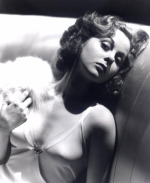 United Artists for Dark Water (1944) (the role went to
Merle Oberon). DeSylva said his reasons for not lending her out were personal telling her
"You’ve been rude, snippy, and uncooperative with stars and directors. Maybe this will teach you." United Artists for Dark Water (1944) (the role went to
Merle Oberon). DeSylva said his reasons for not lending her out were personal telling her
"You’ve been rude, snippy, and uncooperative with stars and directors. Maybe this will teach you."
After making And Now Tomorrow (1944) in which she received third billing after Loretta Young and Alan Ladd, Paramount decided not to renew her contract. Susan started working as a freelancer. On February 19, 1945 she gave birth to twin sons, Timothy and Gregory. Things were not going smoothly in her marriage. Susan often clashed with her husband over his spending habits. She was thrifty. He was not. In 1946, she was hired by RKO to star in Deadline at Dawn which also starred Paul Lucas and
Bill Williams. Also in 1946, she was signed by Independent producer Walter Wanger. The first film she
did for Wanger (at a salary of $200,000) was a picture called Canyon Passage (1946) for
Universal. It was a male oriented action film directed by French expatriate director Jacques
Tourneur. In Newsweek’s review of the film they said "Miss Hayward's bouts with demon run are more to be censored than pitied considering that she is attractive drunk or sober and is apparently immune to hangovers". Next Susan made a film for RKO called They Won't believe Me (1947). Time magazines James Agee wrote that Susan "proficiently sells her special brand of sexiness".  On October 1st 1947, Susan filed for divorce from Jess
Barker on grounds of cruelty and mental anguish. A few weeks later she called it off, deciding to try to
work things out with her husband. On October 1st 1947, Susan filed for divorce from Jess
Barker on grounds of cruelty and mental anguish. A few weeks later she called it off, deciding to try to
work things out with her husband.
Next she starred in The Lost Moment (1947) which also starred Robert Cummings and Agnes Moorehead. Both Susan and Wanger didn`t think much of the film (Wanger said of it "We missed badly on that one".), however its rating on the Internet Movie Database is 7.4 and the comments are generally favorable. Susan's next film was the civil war drama Tap Roots directed by George Marshall. It was filmed in Mississippi. The story involves a community that declares itself independent in the War Between the States. The New York Times wrote that "Susan was generously endowed by nature and further enhanced by Technicolor", but added "she was defeated at every turn of the script". In 1948, Susan starred in The Saxon Charm which co-starred Robert Montgomery and John Payne. The following year she starred in Tulsa (1949) as a half-Indian woman who owns most of the oil fields around Tulsa, Oklahoma. Soon after Darryl F. Zanuck offered to buy Susan`s contract from Wanger for $200,000. Wanger accepted. This was a great move for Susan career-wise as she now had a major studio (Twentieth Century Fox) behind her. Her first Fox production was House of Strangers (1949) which starred Edward G. Robinson an Italian
immigrant turned successful and wealthy banker. Susan received her second Academy Award nomination for best actress for her performance in My Foolish Heart. (Olivia de Havilland won that year for The Heiress). Also in 1950, she turned down the road to appear in Stella (she was replaced by Ann Sheridan). In 1951, she replaced the pregnant Jeanne Crain in Henry King's I'd Climb the Highest Mountain. Next she starred in Rawhide (1951) with Tyrone Power, I Can Get it for You Wholesale (1951) with Dan Dailey and David and Bathsheba (1951) with Gregory Peck. While Susan`s career was flourishing, her husband (also an actor) could barely find work. In 1950, he had only one movie job (The Milkman) which paid him a total of $665. That same year Susan made $175,000. He was once asked when trying to get an acting job why he was there "as his wife was making plenty of money". In December of 1951, Photoplay listed her at number ten on their 12 most beautify women in Hollywood list. Others to make the list were Ava Gardner, Ann Blyth, Elizabeth Taylor, Arlene Dahl, Linda Darnell, Joan Crawford, Mona Freeman, Loretta Young, Marlene Dietrich, Rita Hayworth and Deborah Kerr. In 1952, Susan made the Jan Froman bio-pic With a Song in my Heart. The voice you hear onscreen singing is actually Jan Froman's voice with Susan mouthing the words. Susan received her third Oscar nomination for her performance in With a Song in my Heart. She lost out to Shirley Booth's performance in Come Back, Little Sheba.Next she made The Snows of Kilimanjaro (1952) with Gregory Peck (which was based on an Ernest
Hemingway story). The Lusty Men (1952) with Robert Mitchum and The President`s Lady (1953)
with Charlton Heston (who portrays Andrew Jackson, Susan plays his wife Rachel) which
was one of Susan`s favorite films of hers. Also in 1953, she was reunited with On February 14th, 1953 the Foreign Press Association of Hollywood announced that according to polls of fans from 50 countries the most popular stars of 1952 were John Wayne and Susan Hayward. They both received Henrietta Awards (which would later become The Golden Globes). Later that year, Susan announced that she was filing for divorce from her husband. The unhappiness in her personal life, spilled over to the movie set while making Demetrius and the Gladiators (1954). Co-star Victor Mature said that "Susan acts like someone a hundred years old". Next up was Garden of Evil (1954) starring Gary Cooper which was filmed entirely in Mexico. On August 17th 1954 her divorce from Jess Barker became official. Her income was declared at $17,000 per month; her assets were valued at $1,293,319. She retained custody of the twins. Next Susan made Untamed (1955) directed by Henry King and co-starring Tyrone Power and Soldier of Fortune (1955) with Clark Gable. On April 26th 1955, Susan was hospitalized after consuming an overdose of sleeping pills. It made national headlines. Her suicide attempt was made after a heated argument with her ex-husband. Reverend Billy Graham next sermon was devoted to the evils of Hollywood said that Susan had tried to kill herself because "movie stars are miserable, unhappy people". On November 4th of the same year Susan made some more headlines when actress Jill Jarmyn accused her of beating her with a hair brush after Jarmyn had walked in on Susan and actor Don "Red" Barry in Barry's bedroom. In 1955, she portrayed actress and singer Lillian Roth (who introduced the song When the Red, Red,
Robin Comes Bob, Bob, Bobbin' Along to the world) in I'll Cry Tomorrow. Roth was also an alcohol
w In 1956, Susan starred in The Conqueror with John Wayne. This film was for Howard Hugh'sRKO pictures and was produced and directed by Dick Powell. It was shot in Utah. There has been speculation that the filming of The Conqueror might be connected to the cancer deaths of the people involved with its production (Susan, John Wayne (1907-1979), Agnes Moorehead (1900-1974) John Hoyt (1905-1991) and Dick Powell (1904-1963)). In 1953, the U.S. government exploded an atomic bomb (nickname: "Dirty Harry") in the Nevada desert which left a radioactive atmosphere over St. George, Utah where the film as shot. In February 8th, 1957 Susan eloped with former FBI agent and successful automobile dealer Floyd Eaton Chalkley. San Francisco Examiner reporter Ed Montgomery believed in condemned murderess Barbara Graham was innocent.In 1952 and 1953, her story had been the talk of the nation (especially in California). Producer Walter Wanger commissioned a screenplay to be made from Montgomery's notes. And Susan was eager to star in the picture that came out of it. I Want to Live! was released on October 28th, 1958. Once again Susan was nominated for an
Susan's next film after I Want to Live! was Woman Obsessed (1959) which co-starred Stephen Boyd. Her last film of the 1950s wasThunder in the Sun where she co-starred with Jeff Chandler. In the 1960's Susan made a total of eight films, the most famous being Valley of the Dolls in 1967. On January 9, 1966 her husband died from hepatitis (which was the result of an untreated World War II blood infection). According to a close friend of Susan’s Ron Nelson, Susan "locked herself in the bathroom and yelled her lungs out". Susan sold her Georgia property (which included a private lake, a guest house, 450 acres with cows and the main family residence) and moved to Fort Lauderdale, Florida. In 1968, Susan performed in the musical Mame in Caesar’s Palace in Las Vegas. She was forced to quit when her voice gave out, but only after completing 96 grueling performances. She was replaced by Celeste Holm. On January 22, 1971 a fire went through her ninth floor Fort Lauderdale apartment. She was not injured. In the 1970`s she appeared in three movies Say Goodbye, Maggie Cole (1972) (which was made for TV), The Revengers (1972) and Heat of Anger (1972) (also made for TV). In 1972, that she began to experience severe headaches. When she released from the hospital in May of 1973 she only weighed 85 lbs. She also wore a wig as her hair had fallen out due to the chemotherapy treatment. By December of 1973, she was partially paralyzed on her right hand side. Despite her illness she made an appearance at the 1974 Academy Awards (supported on stage by Charlton Heston). A few weeks later it was revealed that Susan was suffering from a brain tumor. At 2 in the afternoon on March 14th, 1975 Susan Hayward passed away. Her body was flown to Carrollton Georgia so she could be buried beside her husband Floyd Eaton Chalkley. In her will, Susan left $200,000 to her brother Walter and the remainder of her estate ($750,000)
to her two sons Gregory (a veterinarian in Florida) and Timothy (a Hollywood press agent). |
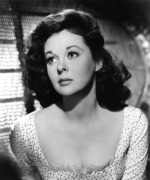 she regained her ability to walk.
she regained her ability to walk.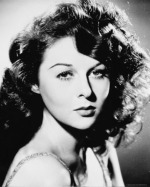 When her six month contact was up with Warner Brothers they decided
to let her go.
When her six month contact was up with Warner Brothers they decided
to let her go.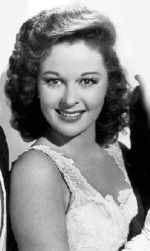 Producer Samuel Bronston borrowed her for the 1943's Jack
London. It was based on a book called The Book of Jack London written by widow Charmian
Kittredge London. Jack London was, of course , the famed adventurer-writer (Call of the
Wild) who lived from 1876 to 1916. Film critic Bosley Crowther wrote at the time that "Frankly, it
must be admitted that the proper film biography of London has not been made yet".
Producer Samuel Bronston borrowed her for the 1943's Jack
London. It was based on a book called The Book of Jack London written by widow Charmian
Kittredge London. Jack London was, of course , the famed adventurer-writer (Call of the
Wild) who lived from 1876 to 1916. Film critic Bosley Crowther wrote at the time that "Frankly, it
must be admitted that the proper film biography of London has not been made yet".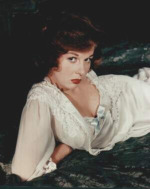 Conway (played by Lee Bowman). The movie has been described as
the female version of The Lost Weekend. Susan was nominated for an Academy Award for her
role in the film. (As were the film`s writers Dorothy Parker and Frank Cavett – they lost to
Sidney Sheldon for The Bachelor and the Bobby-Soxer.) Loretta Young won for her role in
The Farmer's Daughter.
Conway (played by Lee Bowman). The movie has been described as
the female version of The Lost Weekend. Susan was nominated for an Academy Award for her
role in the film. (As were the film`s writers Dorothy Parker and Frank Cavett – they lost to
Sidney Sheldon for The Bachelor and the Bobby-Soxer.) Loretta Young won for her role in
The Farmer's Daughter.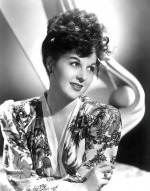 In 1950, Samuel Goldwyn borrowed her for My Foolish Heart
which was based on the J.D. Salinger short story Uncle Wiggily in Connecticut. The popular title
song was composed by Ned Washington and Victor Young and sung in the movie by Martha
Mears who plays a nightclub singer. Variety said of Susan "Her performance is a gem, displaying a
positive talent for capturing reality".
In 1950, Samuel Goldwyn borrowed her for My Foolish Heart
which was based on the J.D. Salinger short story Uncle Wiggily in Connecticut. The popular title
song was composed by Ned Washington and Victor Young and sung in the movie by Martha
Mears who plays a nightclub singer. Variety said of Susan "Her performance is a gem, displaying a
positive talent for capturing reality". Robert Mitchum in White Witch Doctor. The backgrounds were
filmed in Africa, however the two stars never left the lot.
Robert Mitchum in White Witch Doctor. The backgrounds were
filmed in Africa, however the two stars never left the lot.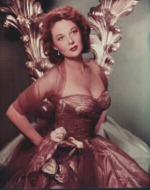 hich Susan portrays very convincingly in this picture. One of the
reasons Susan got the role was Roth herself thought she was perfect for the role. She performed her own
singing in this picture. She garnered her fourth Oscar nomination for I'll Cry Tomorrow losing out to
Anna Magnani in The Rose Tattoo.
hich Susan portrays very convincingly in this picture. One of the
reasons Susan got the role was Roth herself thought she was perfect for the role. She performed her own
singing in this picture. She garnered her fourth Oscar nomination for I'll Cry Tomorrow losing out to
Anna Magnani in The Rose Tattoo.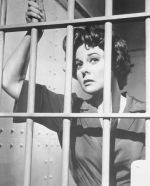 Academy Award, but this time she won.
Academy Award, but this time she won.